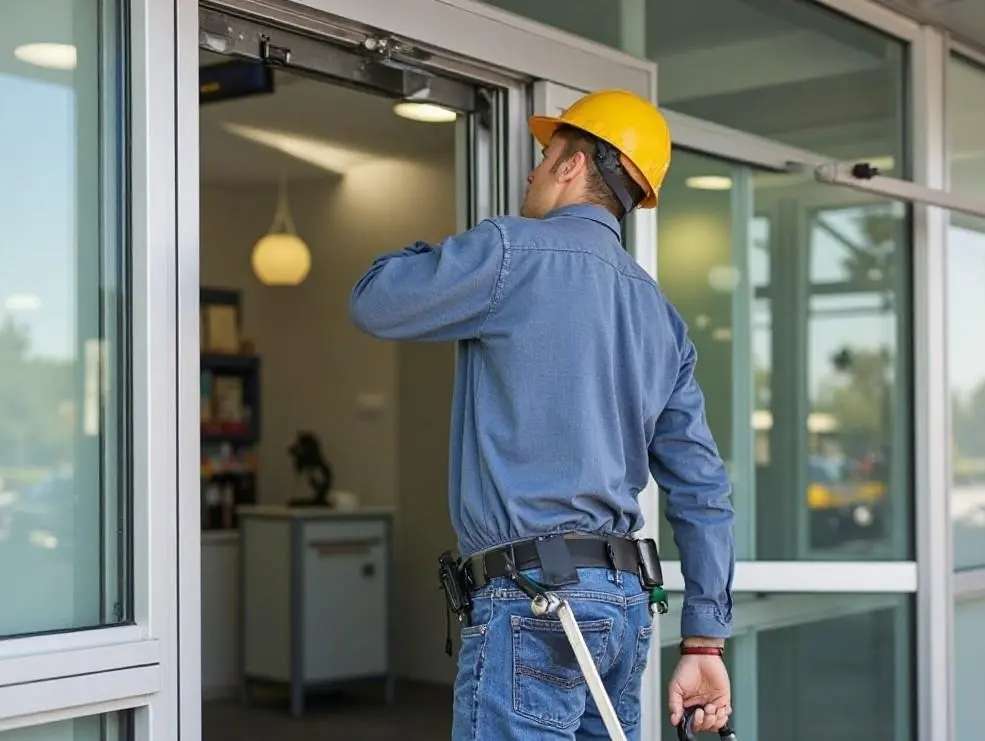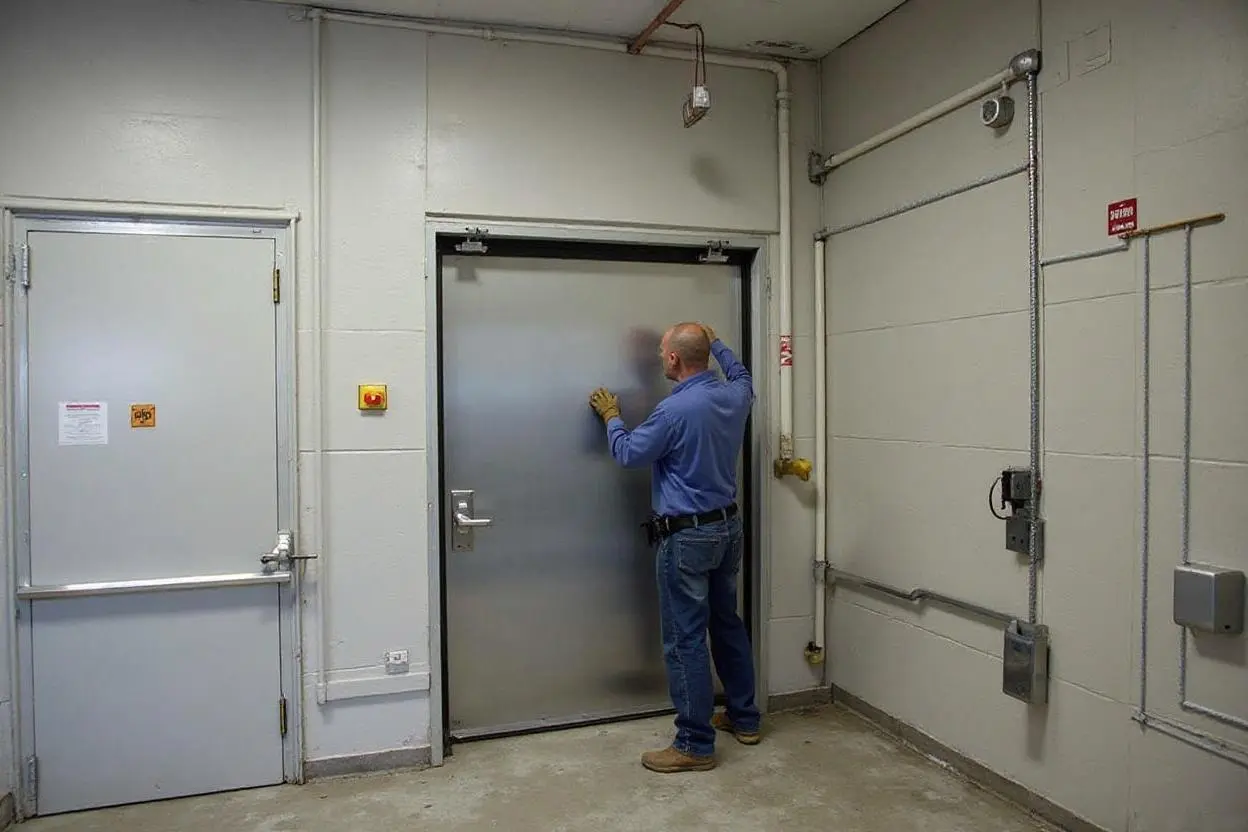How To Fix The Automatic Sliding Door?
Automatic sliding doors do a quiet job all day until they stop opening, start chattering on the track, or hang half-open in a Buffalo snow squall. Fixing them can be simple if the issue is minor, but many problems involve sensors, controllers, and safety standards that require a trained technician. This article explains what a facility manager or building owner can safely check first, what to avoid, and when professional automatic sliding doors repair in Buffalo is the right call.
Start with safety and power
Before any inspection, place cones or a temporary barrier to redirect foot traffic. Post a “Door Out of Service” sign on both sides. Disable the operator with the service switch if the unit has one. If not, turn off power at the disconnect. Never work underneath a moving header or with the door powered unless you are testing under controlled conditions.
Most sliding door outages in retail and medical facilities start with power. Check the breaker panel and the local disconnect above the door. Buffalo buildings see ice and salt; corrosion inside the disconnect or a tripped GFCI can sit at the root of an intermittent outage. If power is good, the next step is a visual check.
Quick checks that solve common issues
A clean track fixes more doors than any other step. Grit, road salt, and leaf debris build up along Main Street entrances and Elmwood storefronts. Vacuum the track, then wipe it with a dry rag. Avoid lubricants on the track. Oil attracts grit and creates a grinding paste that wears rollers.
Look at the door hangers and rollers. Rollers should sit round and smooth, not flattened on one side. A door that thumps every few feet or drifts closed on its own often has a worn roller. Many systems allow height adjustment from a small access hole in the stile. A quarter turn can stop a stile from scraping the floor guide. Do not remove the door leaf unless you know the weight and have a helper; some panels exceed 120 pounds.
Examine the floor guide or guide shoe. A cracked guide lets the lead edge wander, which binds the door. Replace a broken guide before adjusting anything else.
Sensors and approach safety
Approach sensors and safety beams do most of the thinking. In Buffalo’s winter, slush on a sensor lens looks like constant motion. Wipe the lenses with a microfiber cloth. Check the indicator lights on the sensor heads; most brands show green for standby, red for detect, and flashing for fault. If the door stays open, a sensor may be stuck in detect.
For presence safety across the threshold, a misaligned photo eye will hold the door open. Confirm both emitter and receiver are on, clean, and aligned. A piece of cardboard passed through the beam should change the indicator state. If nothing changes, wiring or the controller input may be at fault.
Many operators have a learn or self-calibration mode. Do not trigger this during store hours. A calibration run moves panels to limits and can pinch if the safety field is compromised. If the manual is unavailable, stop here and call a technician.
Control panel and error codes
Behind the header cover sits the operator board. If the door shows a fault code, note it before cycling power. Power-cycling often clears faults temporarily and erases clues. Common fault types include obstruction detection, motor overcurrent, encoder loss, and low-voltage supply.
Loose terminal screws are common in older Buffalo properties with years of vibration and temperature swing. With power off, inspect for A-24 Hour Door National Inc: automatic sliding doors repair Buffalo browned terminals, frayed conductors, and moisture tracks. Water from wind-driven rain on Hertel Avenue can find its way into a poorly sealed header. If the PCB shows corrosion or a burnt smell, skip further tinkering and book service.
Motor and drive train symptoms
A healthy operator starts smooth, ramps to speed, and slows before the jamb. Jerky motion points to flat-spotted rollers or a stretched belt. A loud whine rises with speed when a belt is misaligned. A grinding sound at low speed suggests gearbox wear.

If the door opens but struggles to close, the closing force may be set low after a sensor event. Increasing force can hide an obstruction problem and violates safety standards if adjusted without proper tests. Doors in hospitals and airports must meet ANSI/BHMA A156.10 and A156.38. Adjustments without a load test can create liability. When in doubt, stop and schedule professional automatic sliding doors repair in Buffalo.

Weather, vestibules, and false activations
Lake-effect snow and wind gusts through a Grant Street vestibule can trip sensors. Aim approach sensors down toward the walk-off mat, not across the parking lot. If the door opens whenever a bus rolls by on Niagara Street, the sensor range is set too long. Small tweaks to the detection zone often save energy and reduce wear.
Heaters and HVAC diffusers near the header can move the door slightly during close. That movement can trigger presence sensors and create a constant open-close cycle. Redirect the diffuser or adjust sensitivity with the controller’s documented range. Keep in mind that sensitivity set too low can reduce safety coverage.
A simple homeowner or manager checklist
- Confirm power at breaker and local disconnect, then label the door out of service.
- Clean track, floor guide, sensor lenses, and photo eyes.
- Inspect rollers, hangers, and belt for visible wear or misalignment.
- Observe sensor indicator lights and test the safety beam with a card.
- Note any error codes on the controller before cycling power.
If these steps do not restore normal operation, service is the next step. Replacing belts, encoders, control boards, or glass panels requires training, proper PPE, and parts that match the brand and model.
Brands seen across Buffalo and common quirks
Northtowns shopping centers often use ASSA ABLOY/Record and Stanley units. South Buffalo clinics may have Horton or Besam operators. Each brand has its own programming logic and sensor defaults. For instance, some Stanley models throw a “C2” code for obstruction and will not clear until a full learn cycle runs with both travel paths free. Horton operators often report motor overcurrent after a snow drift nudges the panel off plumb. Knowing these patterns speeds a fix and prevents repeated callbacks.
Compliance and liability
Automatic doors are life-safety devices. ANSI/BHMA standards require annual inspections and daily safety checks. Many insurance carriers in New York ask for maintenance logs. A simple daily test at opening time catches problems early: approach from both sides, break the threshold beam with a foot while the door closes, and confirm the door reverses. If it does not, take the door out of service. A-24 Hour Door National Inc. documents every repair and can set up quarterly or semiannual service to meet audit requirements.
Costs, timing, and what to expect in Buffalo
Minor adjustments and cleaning usually fall in the lower price range. Sensor replacements and new belts sit midrange. Control boards and glass replacements cost more and may require a return visit if special-order parts are needed. In Buffalo, same-day service is common for critical entries. Weather can affect response times during heavy snow, but the team maintains 24/7 coverage for hospitals, pharmacies, and grocery stores that cannot close.
A typical on-site diagnosis takes 45 to 90 minutes. If parts are on the truck, repairs often finish within two hours. For custom tempered glass panels, lead times run from 3 to 7 business days. During that time, temporary boarding or a manual sliding setup may keep the entrance usable and secure.
When to stop DIY and call a pro
Stop if any of the following appear: cracked glass, burnt odor from the header, repeated fault codes after power cycling, door slamming shut, or inconsistent response from safety sensors. These issues can injure a customer or staff member and expose the business to claims. A technician with the proper test tools can verify hold-open times, approach zones, and closing forces to code.
Why local service makes a difference
Buffalo conditions punish hardware. Salt eats floor guides. Ice loads drag rollers off track. Sensors see snow flurries as motion. A local crew knows these patterns and stocks the right rollers, belts, and sensors for the brands common on Delaware Avenue, Transit Road, and across Cheektowaga and Amherst. That cuts downtime and keeps entrances safe through winter.
Book automatic sliding doors repair in Buffalo
If an entrance is stuck open, chattering across the track, or showing a fault, A-24 Hour Door National Inc. is ready to help. The company services retail, healthcare, office parks, and multifamily buildings across Buffalo, Tonawanda, Orchard Park, and West Seneca. Technicians carry parts for major brands and perform code-compliant testing after every repair.
Call to schedule same-day automatic sliding doors repair in Buffalo or request a quote online. Share the brand, approximate age, and any error codes on the display. A quick photo of the header and track also helps the dispatcher send the right parts on the first visit.
A-24 Hour Door National Inc provides commercial and residential door repair in Buffalo, NY. Our technicians service and replace a wide range of entry systems, including automatic business doors, hollow metal frames, storefront entrances, fire-rated steel and wood doors, and both sectional and rolling steel garage doors. We’re available 24/7, including holidays, to deliver emergency repairs and keep your property secure. Our service trucks arrive fully stocked with hardware, tools, and replacement parts to minimize downtime and restore safe, reliable access. Whether you need a new door installed or fast repair to get your business back up and running, our team is ready to help. A-24 Hour Door National Inc
344 Sycamore St Phone: (716) 894-2000 Website: https://a24hour.biz/buffalo
Instagram: @a24hourdoor
Buffalo,
NY
14204,
USA
Facebook: 24 Hour Door
Yelp: A-24 Hour Door National (Buffalo)
X (Twitter): @a24hrdoor